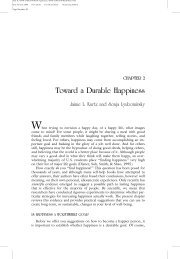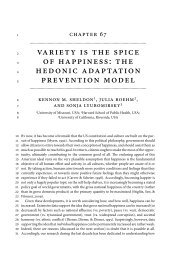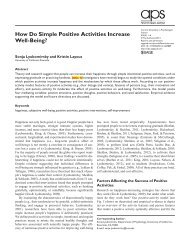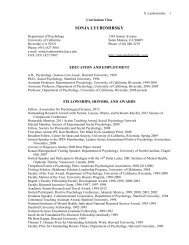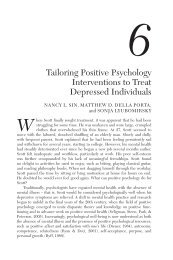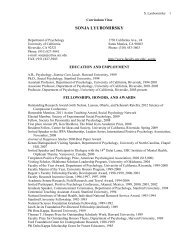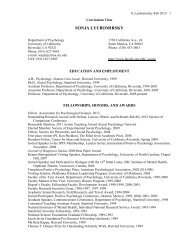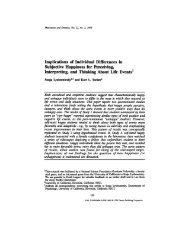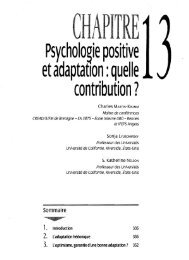Maximizing Versus Satisficing: Happiness Is a Matter of Choice
Maximizing Versus Satisficing: Happiness Is a Matter of Choice
Maximizing Versus Satisficing: Happiness Is a Matter of Choice
Create successful ePaper yourself
Turn your PDF publications into a flip-book with our unique Google optimized e-Paper software.
MAXIMIZING VS. SATISFICING AND WELL-BEING<br />
1187<br />
controlling for dispositional happiness. Furthermore, our findings<br />
regarding consumer behavior suggest that social comparisons and<br />
product comparisons stimulated counterfactual thoughts, which<br />
then engendered regret (see, e.g., Roese, 1997). Although a measure<br />
<strong>of</strong> general counterfactual thinking was not included in this<br />
study, recent research indicates that maximizers ruminate more<br />
than satisficers (White, Lehman, & Schwartz, 2002). It may be the<br />
case that counterfactual thinking and ruminative thoughts are<br />
related to the general regret reported by maximizers, as well as to<br />
consumption-related regret. Thus, it appears that striving for the<br />
best things in life may have paradoxical consequences.<br />
Intuition, along with previous research (e.g., Morse & Gergen,<br />
1970), suggests that whereas upward social comparison might<br />
yield regret and unhappiness, downward social comparison might<br />
yield elation. Study 2 found no such mood enhancing effects <strong>of</strong><br />
downward social comparison. However, a close look at the recent<br />
literature on social comparison suggests that consistent positive<br />
effects <strong>of</strong> downward social comparison are reliably reported only<br />
for individuals who have low self-esteem or experience physical or<br />
psychological threat (e.g., Affleck & Tennen, 1991; Aspinwall &<br />
Taylor, 1993; Gibbons & Gerrard, 1989; Taylor, 1983; see Wills,<br />
1991, for a review). In the general population, the mood effects <strong>of</strong><br />
social comparison are much less predictable. Recent findings suggest<br />
that the affective consequences <strong>of</strong> social comparison are not<br />
intrinsic to its direction (e.g., Buunk, Collins, van Yperen, Taylor,<br />
& Dak<strong>of</strong>, 1990). That is, both upward and downward comparisons<br />
can have positive or negative implications for the self (e.g., Brewer<br />
& Weber, 1994; Brown, Novick, Lord, & Richards, 1992; Buunk<br />
et al., 1990; Hemphill & Lehman, 1991; Lockwood & Kunda,<br />
1997; Taylor, Buunk, & Aspinwall, 1990; Tesser, 1988; Wood &<br />
VanderZee, 1997).<br />
A limitation <strong>of</strong> Study 2 is that although it relied on reports <strong>of</strong><br />
real-life experiences, these were merely recalled by participants.<br />
Because participants’ recollections <strong>of</strong> the purchasing situation<br />
could be biased or incomplete, it is important to assess social<br />
comparison, happiness, and regret among maximizers and satisficers<br />
in other settings as well. Thus, Study 3 attempted to examine<br />
reactions to social comparison information in a controlled laboratory<br />
setting.<br />
Study 3. <strong>Maximizing</strong>, <strong>Satisficing</strong>, and Social Comparison<br />
Because maximizers are continually chasing the best possible<br />
option when making a decision, they try to gather and analyze all<br />
<strong>of</strong> the information available to them. Information about one’s<br />
relative standing with one’s peers—that is, social comparison<br />
information—is likely to be an important source <strong>of</strong> information in<br />
their decision-making process. Thus, maximizers are expected to<br />
be more interested in social comparison feedback and more sensitive<br />
to such feedback than satisficers.<br />
Accordingly, the primary hypothesis tested in Study 3 was that<br />
the moods and self-evaluations <strong>of</strong> maximizers would be more<br />
vulnerable or sensitive to unsolicited social comparison information<br />
than would those <strong>of</strong> satisficers. This study asked participants<br />
to solve anagrams at whatever rate they were capable, but manipulated<br />
the ostensible performance <strong>of</strong> an undergraduate peer so that<br />
participants experienced relative “success” (i.e., their peer performed<br />
worse than themselves) or relative “failure” (i.e., their peer<br />
performed better than themselves). This paradigm was developed<br />
by Lyubomirsky and Ross (1997, Study 1), who found support for<br />
a parallel prediction regarding chronically unhappy and happy<br />
individuals. That is, in their study, self-rated unhappy students who<br />
solved puzzles in the presence <strong>of</strong> a faster peer showed smaller<br />
increases in mood and self-confidence and expressed greater<br />
doubts about their own ability than those exposed to a slower peer.<br />
Happy individuals, by contrast, did not exhibit this pattern <strong>of</strong><br />
sensitive responding to social comparison feedback.<br />
Study 3 was characterized by several notable features. First, to<br />
minimize possible experimental demand characteristics and suspicion<br />
on the part <strong>of</strong> participants, and to simulate typical “realworld”<br />
peer comparison contexts, social comparison information<br />
was provided indirectly. That is, the experimenter never explicitly<br />
<strong>of</strong>fered any comparison <strong>of</strong> performances, although such information<br />
was made highly salient to the participants. Second, the<br />
relevant task and dimension <strong>of</strong> evaluation (i.e., anagram-solving<br />
ability) was one about which participants were unlikely to have<br />
objective standards for evaluating their performance. Finally, participants<br />
enjoyed wide latitude in managing the social comparison<br />
information they faced. That is, they were free to minimize or<br />
maximize the relevance, importance, and controllability <strong>of</strong> the<br />
evaluation dimension; they were free to compete with, identify<br />
with, or simply ignore their more or less successful peer; and they<br />
were free to attribute their own performance and/or that <strong>of</strong> their<br />
peer to whatever factors they wished.<br />
To summarize, whereas in Study 2, participants only responded<br />
to questions regarding their social comparison tendencies in connection<br />
with consumer choices, Study 3 used a more powerful and<br />
more direct manipulation <strong>of</strong> social comparison information, one<br />
involving a real-life peer performing alongside the participant in<br />
the laboratory. And in Study 3, rather than measuring participants’<br />
interest in and seeking <strong>of</strong> such comparison information, we examined<br />
the actual effects <strong>of</strong> social comparison information provided<br />
by the context.<br />
Overview<br />
Method<br />
In the context <strong>of</strong> a purported study <strong>of</strong> cognitive performance, maximizers<br />
and satisficers (as categorized by their earlier responses to the Maximization<br />
Scale) solved anagram puzzles while a supposed peer (who was<br />
actually an experimental confederate) ostensibly completed the same set <strong>of</strong><br />
anagrams much faster or much slower than themselves. Participants rated<br />
themselves with respect to their current mood and anagram-solving ability<br />
both before and after completion <strong>of</strong> the anagram-solving task.<br />
Participants<br />
Fifty-four students enrolled in an introductory psychology course at the<br />
University <strong>of</strong> California, Riverside received course credit for their participation<br />
in this study. Participants were selected on the basis <strong>of</strong> their<br />
responses to the 13-item Maximization Scale, which was presented in the<br />
context <strong>of</strong> a mass-administered questionnaire (n 82). Responses to the 13<br />
items, which displayed good internal consistency ( .79), were combined<br />
and averaged to provide a single composite score, ranging from 2.6<br />
to 6.7, with a median <strong>of</strong> 4.2 on the 7-point scale.<br />
A sample <strong>of</strong> 26 maximizers and 28 satisficers, that is, those whose<br />
composite scores were respectively either in the top or bottom third <strong>of</strong> the<br />
distribution, were recruited for the study by telephone. The maximizers’<br />
group mean on the Maximization Scale was 5.26 (SD 0.50), whereas the



